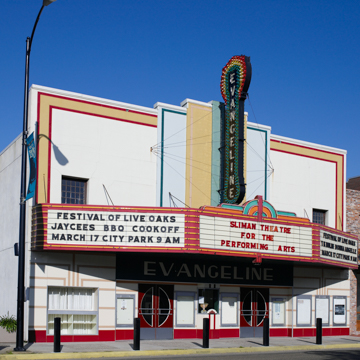You are here
Sliman Theatre for the Performing Arts
This colorful building, originally a wholesale grocery store built around 1900, was transformed into a movie theater by Lebanese immigrant Kalil Sliman in 1929. Sliman named the theater after Henry Wadsworth Longfellow's Acadian heroine in his romantic poem "Evangeline" (1847)—a designation that conjured a legendary regional character in a setting ideally suited to escapism—and added a vertical sign at one corner of the facade, spelling this out in white letters on a dark blue background.
In 1940, Sliman's son Theodore, with the assistance of Lafayette-based architect Bowen, refashioned the facade in an Art Deco mode. The vertical sign was moved to the center of the facade and its top features a red, yellow, and green sunburst outlined with electric lights, thus making the theater highly visible at night, as well as during the day. A glass ticket booth was set in the center of the facade between the two entrance doors, and the lower half of the building is faced with red and peach-colored Carrara glass intersected by bands of gold-colored glass. Bowen also added a yellow and red, angle-shaped marquee with neon light strips and painted the upper facade red, white, green, and yellow. When the movie house closed in the 1960s—a time period when television drove many small-town movie houses out of business—the Sliman family donated the building to the city. The theater was renovated in the 1990s as a center for performing arts and community events, and renamed for its original owner. Although the auditorium has been altered for its new uses, the lobby retains such original details as the stairs and light fixtures.
Writing Credits
If SAH Archipedia has been useful to you, please consider supporting it.
SAH Archipedia tells the story of the United States through its buildings, landscapes, and cities. This freely available resource empowers the public with authoritative knowledge that deepens their understanding and appreciation of the built environment. But the Society of Architectural Historians, which created SAH Archipedia with University of Virginia Press, needs your support to maintain the high-caliber research, writing, photography, cartography, editing, design, and programming that make SAH Archipedia a trusted online resource available to all who value the history of place, heritage tourism, and learning.

